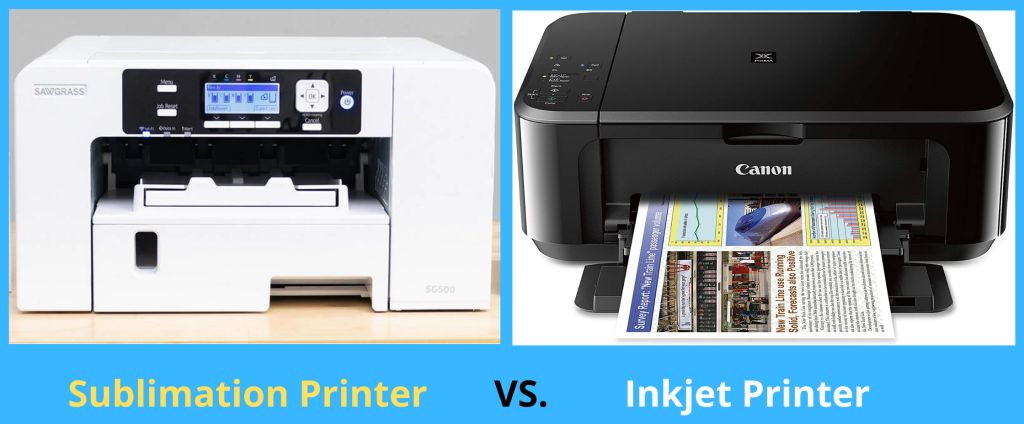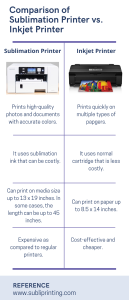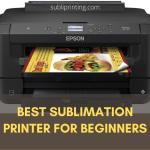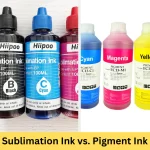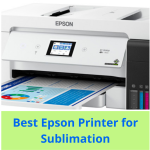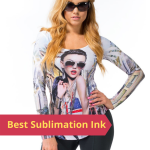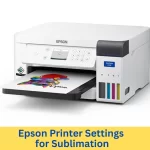Sublimation printers and inkjet printers are two popular types of printers for creating high-quality prints. Although they both are used for printing, there are some key differences between the two. Sublimation printers use specific printing technology to print designs on sublimation paper using dye sublimation ink. Inkjet printers, on the other hand, use tiny nozzles to spray the ink onto paper to create prints.
Let’s take a deep look at the differences between a sublimation printer and regular inkjet printer, and see the comparison of both to help you decide which one is right for your needs.
Contents
Difference between Sublimation Printer vs Inkjet Printer
The main difference is that an inkjet printer squirts tiny drops of liquid ink onto paper to create a print, while a sublimation printer uses heat to turn solid dye into gas, which then turns into a solid state after penetrating into the surface of the substrate.
As someone who has experienced both inkjet and sublimation printers, I can confidently highlight the key differences between these two types.
1. Printing Technology
Sublimation printers do sublimation printing, which involves the transformation of specialized sublimation inks from a solid to a gas state, resulting in vibrant and permanent prints.
On the other hand, regular printers utilize inkjet or laser printing methods to transfer ink onto paper.
2. Print Output
The output from a sublimation printer is remarkable. The prints are vivid, long-lasting, and resistant to fading. The sublimated ink becomes part of the material itself, giving it a professional and seamless finish.
On the other hand, regular printers offer temporary prints that vary in terms of durability and color accuracy.
3. Material Compatibility
Sublimation printers offer versatility in terms of the materials they can print on. They can handle fabrics like polyester and cotton, ceramics, metal, glass, wood, and more, allowing for a wide range of creative applications.
Regular printers, however, are primarily designed for paper-based printing, limiting their material compatibility.
4. Color Capability
Sublimation printers stand out at reproducing full-color designs with exceptional detail and gradient consistency. They can accurately render photographs and complex graphics, making them an ideal choice for projects that require high-resolution prints.
Regular printers, on the other hand, offer color printing as well, but the color accuracy and vibrancy may vary depending on the printer’s quality, and of course the ink’s quality.
5. Prints’ Durability
Sublimation prints have outstanding durability. Since the ink becomes a permanent part of the material’s surface, the prints can withstand repeated washings, exposure to sunlight, and general wear and tear.
In contrast, prints from regular printers may fade or deteriorate over time, especially if not protected or laminated.
6. Printing Capacity
Most sublimation printers are designed to print large format prints. They can print on transfer paper sizes up to 13×19 inches efficiently.
On the other hand, inkjet printers can only print on paper sizes up to 8.5x11 inches.
7. Cost Considerations
Sublimation printers may have a higher initial setup cost due to the specialized equipment and inks required. The cost per print can also be higher, considering the expense of sublimation inks and specialized materials.
Regular printers generally have a lower initial cost and more affordable ink replacement options.
8. Maintenance
Sublimation printers require more maintenance than inkjet printers. This is because sublimation ink is more prone to drying out than regular ink. If the sublimation ink dries out, it can clog the print heads and cause the printer to malfunction. To prevent this, keep the sublimation printer clean and well-maintained.
Additionally, sublimation printers often require periodic replacement of parts such as the heat plate or the transfer belt to ensure consistent and accurate printing.
On the other hand, inkjet printers require less maintenance than sublimation printers. This is because inkjet ink is less prone to drying out than sublimation ink.
Comparison of Sublimation Printer vs Inkjet Printer
Here is the comparison table of the sublimation printer and a regular inkjet printer;
Feature | Sublimation Printer | Regular Printer |
| Technology | Heat transfer | Inkjet or laser |
| Printing Process | Heats ink until it turns into a gas and diffuses into the substrate | Deposits ink in a raster pattern on paper |
| Ink | Sublimation ink | Dye or pigment ink |
| Substrates | Transfer paper, fabric, ceramic, metal, glass, etc. | Paper |
| Durability | Permanent and fade-resistant | Not as permanent |
| Cost | More expensive | Less expensive |
Can I Use Sublimation Ink in a Normal Printer?
No, you cannot use sublimation ink in a regular printer. Sublimation ink is specially formulated with unique properties to undergo a transformation from a solid to a gaseous state without turning into a liquid.
This ink is specifically designed for sublimation printing, which requires a different printing process than what a normal printer supports.
If we look at the real facts, sublimation ink requires a higher temperature to vaporize the dye particles. Regular printers do not get hot enough to vaporize sublimation ink, so the ink will not transfer properly to the substrate.
Regular printers, on the other hand, use dye or pigment ink. Dye ink is made up of small dye molecules that are suspended in a liquid. When the ink is sprayed onto paper, the dye molecules are absorbed into the paper fibers.
Final Words
So, which is better: a dye photo sublimation printer or a regular inkjet printer? Ultimately, this decision depends on your needs and budget.
If you want to customize your items and are looking for a printer that can produce high quality designs on a variety of substrates, then a sublimation printer may be the right choice for you.
However, if you value versatility, cost-effectiveness, and the ability to handle a variety of printing tasks on papers, an inkjet printer may be more suitable.
Frequently Asked Questions
Can you use inkjet printer for sublimation?
Yes, you can use an inkjet printer for sublimation, but the results may not be as good as those produced by a dedicated sublimation printer. Additionally, using an inkjet printer for sublimation may void its warranty.
Which is better inkjet or sublimation?
Ultimately, the decision between an inkjet printer and a sublimation printer depends on your needs and budget. If you need a printer that can create accurate and vibrant colors, then a sublimation printer is the best option. However, if you are looking for a budget-friendly printer that can still produce decent-quality prints, an inkjet printer is the better choice.
Is it worth getting a sublimation printer?
A dye photo sublimation printer is more expensive than a regular inkjet printer, but the results may be worth the extra cost. A sublimation printer can produce high-quality prints with accurate colors, which is ideal for printing photos.
What is the difference between a sublimation printer and regular printer?
A sublimation printer is a type of printer that uses sublimation ink to produce high-quality prints. A regular inkjet printer uses cartridges to produce prints. Additionally, a sublimation printer can print on a larger paper size than a regular inkjet printer.
- 5 Best 13×19 Sublimation Printer for Wide Format Substrates - December 27, 2023
- Best 11×17 Sublimation Printer to Print Tabloid Size Paper - December 26, 2023
- Epson ET-8550 vs ET-15000: Best Wide-Format EcoTank Printer - December 25, 2023

